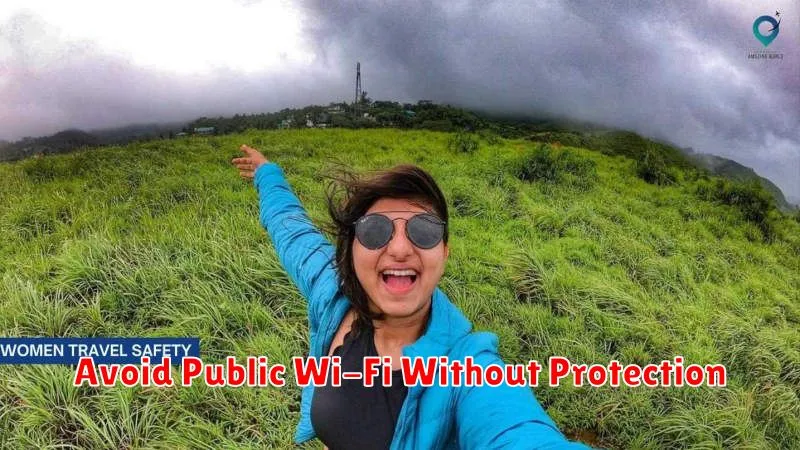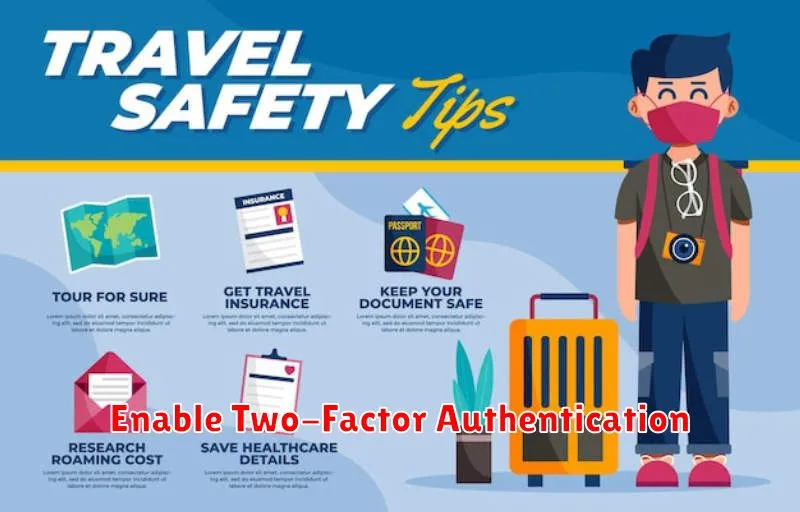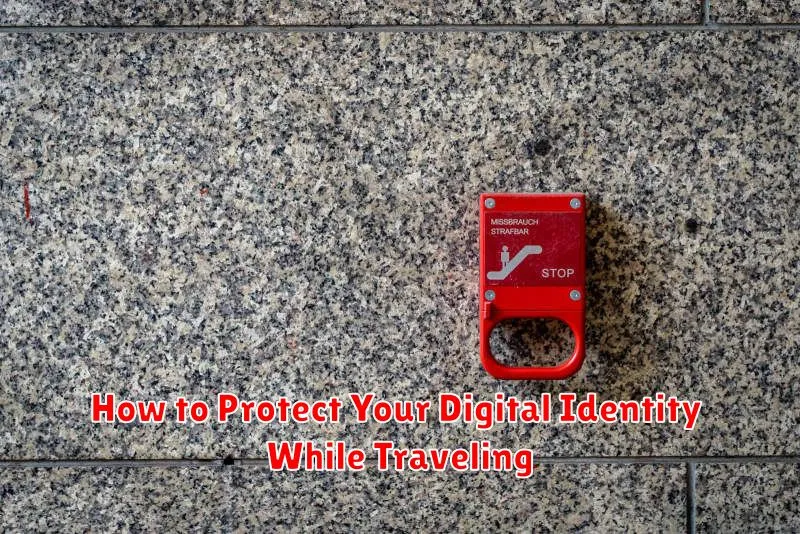In today’s interconnected world, protecting your digital identity is paramount, especially while traveling. Travel often necessitates connecting to public Wi-Fi networks, accessing sensitive information online, and utilizing various digital platforms, all of which can expose you to cybersecurity threats. Understanding how to safeguard your personal data, financial information, and online accounts is crucial for a safe and worry-free travel experience. This article will provide practical and effective strategies to enhance your digital security while you are away from home.
From securing your devices and passwords to utilizing VPNs and practicing safe browsing habits, we will cover essential steps to mitigate risks and protect your digital footprint. Whether you are a seasoned traveler or planning your first trip, learning how to protect your digital identity is an investment in your peace of mind. By implementing the recommendations outlined in this guide, you can significantly reduce your vulnerability to cyberattacks and enjoy a secure and connected travel experience.
Why Travelers Are Vulnerable Online
Travelers are particularly susceptible to cyberattacks due to several key factors. Public Wi-Fi networks, often utilized by travelers for convenience, frequently lack robust security measures, leaving devices vulnerable to data breaches. Connecting to unsecured networks allows hackers to intercept sensitive information like passwords and credit card details.
Increased device usage while traveling also contributes to vulnerability. Whether accessing travel documents, booking accommodations, or staying connected with family and friends, travelers rely heavily on their devices, increasing their digital footprint and potential points of attack.
Furthermore, travelers often lower their security awareness when abroad. Preoccupied with navigating unfamiliar environments and enjoying their trip, they may be less diligent about checking website security or avoiding suspicious links, making them easier targets for phishing scams and malware.
Finally, reliance on unfamiliar networks and systems, such as public charging stations or internet cafes, increases the risk of data compromise. These systems may be compromised with malware designed to steal information from connected devices.
Use a Trusted VPN at All Times
Maintaining your digital security while traveling requires consistent use of a Virtual Private Network (VPN). A VPN encrypts your internet traffic, shielding your online activity from prying eyes on public Wi-Fi networks, which are often unsecured. This encryption prevents potential hackers from intercepting sensitive data like passwords, credit card numbers, and browsing history.
Selecting a reputable VPN provider is crucial. Look for providers with a strong track record of privacy and security, clear logging policies (ideally a no-log policy), and robust encryption protocols. A paid VPN service generally offers better security and performance compared to free options.
Activate your VPN before connecting to any public Wi-Fi network. This proactive approach ensures your data is protected from the moment you go online. Remember to keep your VPN active throughout your travel, even when using seemingly safe networks. Consistency is key to effective digital security.
Avoid Public Wi-Fi Without Protection

Public Wi-Fi hotspots are convenient, especially while traveling, but they pose a significant risk to your digital identity. These networks often lack robust security measures, making your data vulnerable to interception by cybercriminals.
When you use public Wi-Fi, avoid accessing sensitive information like online banking, email accounts, or social media profiles. If you must connect, use a virtual private network (VPN). A VPN encrypts your internet traffic, shielding your data from prying eyes on the network. This added layer of security is crucial when dealing with financial transactions or accessing personal information.
Consider using your phone as a personal hotspot as a safer alternative to public Wi-Fi. Although it may consume mobile data, it offers better security than unprotected public networks.
Always verify the legitimacy of the Wi-Fi network. Double-check the network name with the establishment providing it to avoid connecting to a malicious “twin” network set up by hackers.
Don’t Log Into Sensitive Accounts
While traveling, minimize access to sensitive accounts like banking, investment, or email accounts. Public Wi-Fi networks, often found in hotels, airports, and cafes, can be vulnerable to hacking. Even if a network appears secure, it’s best to err on the side of caution. Avoid checking these accounts unless absolutely necessary.
If you must access a sensitive account, use a virtual private network (VPN). A VPN encrypts your internet traffic, adding a layer of security. Ensure you are using a reputable VPN provider. Even with a VPN, exercise caution. After accessing your accounts, immediately log out and clear your browsing history and cookies.
Consider setting up two-factor authentication (2FA) on all sensitive accounts before your trip. This extra security measure makes it significantly harder for unauthorized individuals to gain access, even if they obtain your password.
Secure Your Phone with Strong Passwords
Your phone often serves as a gateway to much of your digital life, making it a prime target for thieves. Strong, unique passwords are crucial. Avoid easily guessable passwords like “1234” or your birthday. Instead, utilize a combination of uppercase and lowercase letters, numbers, and symbols.
Consider a password manager. These applications generate and securely store complex passwords for all your accounts, eliminating the need to remember them all. A good password manager also facilitates using unique passwords for each online service, significantly enhancing your security.
Enable your phone’s screen lock, utilizing a strong PIN, password, or biometric authentication like fingerprint or facial recognition. This prevents unauthorized access if your phone is lost or stolen. A strong screen lock is your first line of defense.
Two-factor authentication (2FA) adds an extra layer of security. Even if someone obtains your password, they’ll still need a second factor, like a code sent to your phone or email, to access your accounts.
Enable Two-Factor Authentication

Two-factor authentication (2FA) adds an extra layer of security to your online accounts. It requires not only your password but also a second factor, usually something you possess, like a code from an authenticator app or a text message sent to your phone. This makes it significantly harder for unauthorized individuals to access your accounts, even if they obtain your password.
Most major online services, including email, social media, and financial institutions, offer 2FA. Enabling 2FA is often straightforward, typically found within the account security or login settings. Look for options like “Two-Factor Authentication,” “Two-Step Verification,” or “Multi-Factor Authentication.”
While traveling, 2FA becomes especially crucial. Public Wi-Fi networks, commonly used by travelers, can be insecure. If your password is compromised on a public network, 2FA acts as a vital safeguard, preventing unauthorized access to your sensitive data.
Choose an authenticator app rather than SMS whenever possible, as authenticator apps are generally more secure.
Use Backup Emails or Devices for Security
When traveling, access to your primary email account might be compromised due to unforeseen circumstances like device loss or theft. Having a backup email account is crucial for recovering other accounts and receiving important security notifications.
Ensure this backup email is separate from your primary one and uses a different password. Regularly check this account, especially when traveling, to stay informed about any security alerts.
Consider carrying a secondary device, such as a basic phone or tablet. This can be invaluable if your primary device is lost, stolen, or damaged. A secondary device provides a way to access your backup email, contact emergency services, and manage essential online accounts.
Before your trip, ensure your two-factor authentication (2FA) is set up on all critical accounts, and that your backup email or device is a designated recovery method. This adds an extra layer of protection, making it significantly more difficult for unauthorized access even if your password is compromised.

